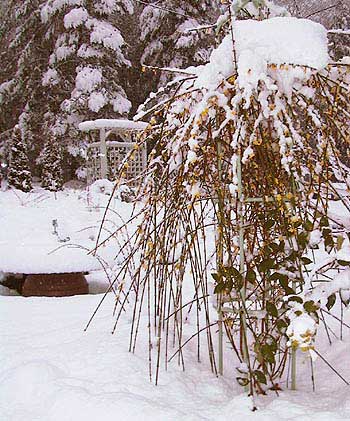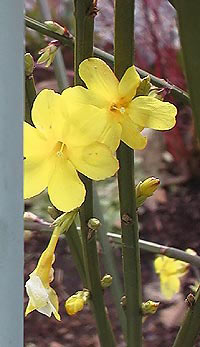Jasminum nudiflorum
WINTER JASMINE
Family: Oleaceae
Pronounced: jas-MEE-num new-dih-FLOOR-um
Quick Jumps
Growing Guide
Rainy Side Notes
GROWING GUIDE

Origin:
Western China.
Plant Group:
Shrubs.
Hardiness:
Sunset zones: 3-21.
USDA zones: 6-10.
Mature size:
Height: 10 feet (3 m).
Width: 10 feet (3 m).
Flowering period:
January through March says Sunset; in my garden; November through March with a sprinkling of blooms in April.
Flowering attributes:
Flower is salverform, one inch (3-4 cm), bright yellow flowers with no fragrance. In November the flowers start blooming at the base of the stems and slowly bloom up the stems. By late winter/early spring, it flowers at the tips of the stems.
Leaf attributes:
Bright, glossy, green pinnate leaves divided into 3 oblong leaflets.
Growth habit:
Deciduous, vine-like shrub.
Light:
Full sun in the Pacific Northwest.
Soil:
Fertile, well-drained soil.
Feeding:
In spring side-dress with composted manure or compost and a complete organic fertilizer. Fertilize during growth period with a low nitrogen fertilizer about once a month.
Propagation Methods:
Layer stems in the fall, or take semi-ripe cuttings in summer.
Pruning Methods:
Occasional severe pruning when it gets overcrowded, after it is finished flowering will benefit this shrub. It can be pruned to make a 3-foot tall hedge. Every 5 to 6 years, rejuvenate the shrub by cutting it down to within 6 inches of the soil.
Pests and Diseases:
No serious problems.
Rainy Side Notes


Rainy Side Notes
This shrub is necessary for anyone with a winter garden. I planted mine close to the front door so I could enjoy it all winter long. It is trained up a five-foot tall obelisk and after three years, it reached the top and now flows down the sides. This also is a good shrub for cascading down over walls. Wherever the stems touch the soil, it roots.
J. nudiflorum is a winter charmer blooming on leafless stems. Another choice jasmine for winter blooming is J. mesnyi with similar growth habits and flowers.
Although it does not look like much during our spring and summer, by mid-fall it begins its flower show that makes the winter garden look spectacular!
Photographed in author's garden.

Gardening for the Homebrewer: Grow and Process Plants for Making Beer, Wine, Gruit, Cider, Perry, and More
By co-authors Debbie Teashon (Rainy Side Gardeners) and Wendy Tweton

